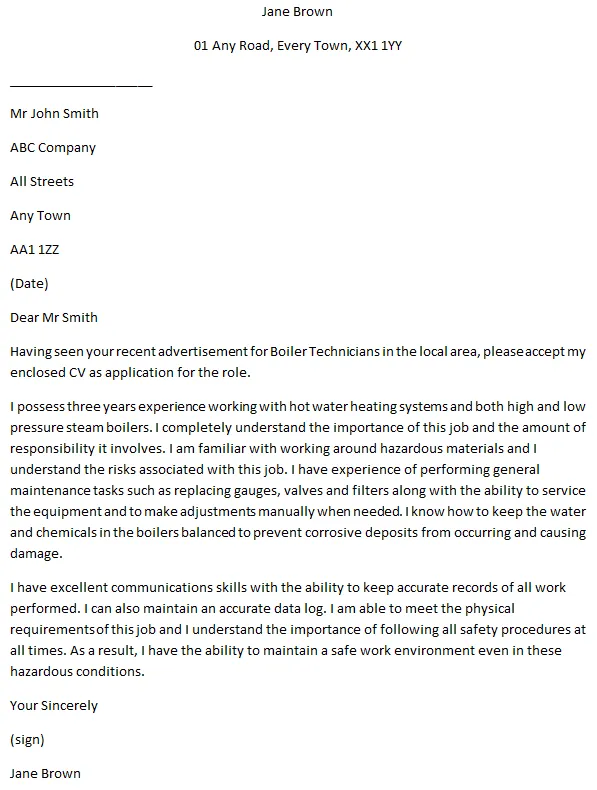Understanding the Technician Cover Letter
A technician cover letter is a crucial document that accompanies your resume when applying for a technician position. It serves as your initial introduction to a potential employer, providing an opportunity to showcase your qualifications, skills, and enthusiasm. Unlike your resume, which presents a factual overview of your experience, the cover letter allows you to express your personality, explain your career goals, and demonstrate your understanding of the specific job requirements. A well-crafted cover letter can significantly increase your chances of securing an interview, as it highlights why you are the ideal candidate for the role.
Why a Cover Letter Matters
In today’s competitive job market, a cover letter is often the deciding factor that sets you apart from other applicants. It allows you to personalize your application, demonstrating that you’ve taken the time to understand the company and the specific requirements of the position. Many employers prioritize cover letters as they provide valuable insights into your communication skills, your ability to articulate your value, and your genuine interest in the opportunity. A strong cover letter can transform a simple application into a compelling narrative that showcases your unique qualifications and motivates the hiring manager to read your resume with greater interest.
Key Components of a Technician Cover Letter
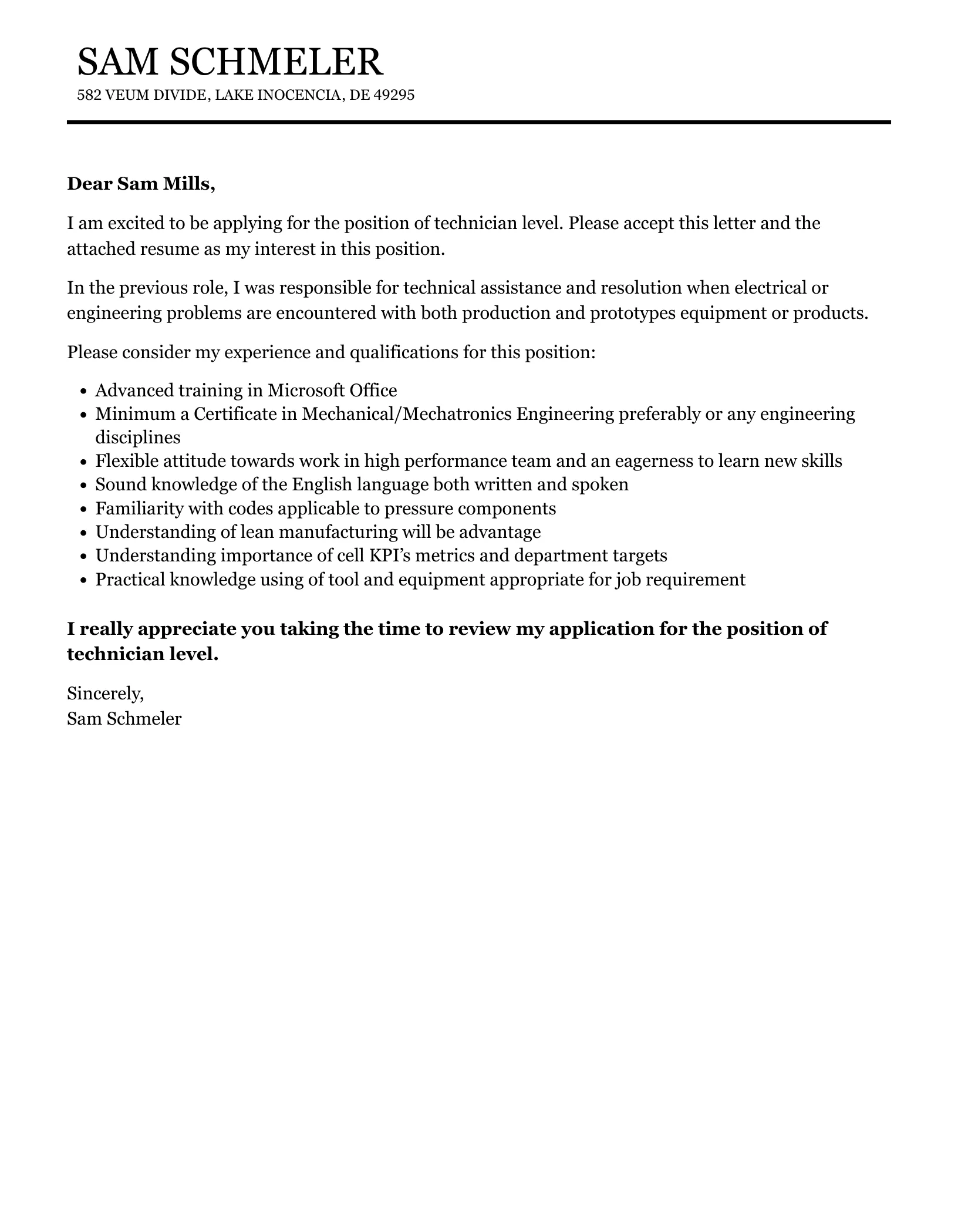
A well-structured technician cover letter typically includes several key components. These elements work together to create a cohesive and persuasive narrative. Understanding each component is essential to crafting a successful cover letter that captures the reader’s attention and makes a strong impression. The key sections provide a clear and concise overview of your qualifications and your suitability for the role, making it easy for the hiring manager to see your potential. This ensures your application is polished and professional, increasing your chances of landing an interview.
Header Information
The header of your cover letter is the first element the hiring manager will see. It should include your contact information, as well as the recipient’s details. Proper formatting and accuracy are key. The goal is to provide easy access to your contact details, such as your name, address, phone number, and email address, while also clearly identifying the company you are addressing the letter to. This demonstrates professionalism and allows for effortless communication. Ensure your header is clean, well-organized, and uses a professional font. Consider the layout and presentation of your header to make a positive first impression. (Image filename technician-cover-letter-header)
Your Contact Information
Start with your full name, followed by your current address, phone number, and professional email address. Ensure that your email address is appropriate and professional. Avoid using nicknames or informal language. Double-check that all information is up-to-date and accurate. Accuracy is paramount in this section, as it ensures the hiring manager can easily reach you for further steps in the hiring process. This small detail shows attention to detail and professionalism.
Recipient’s Contact Information
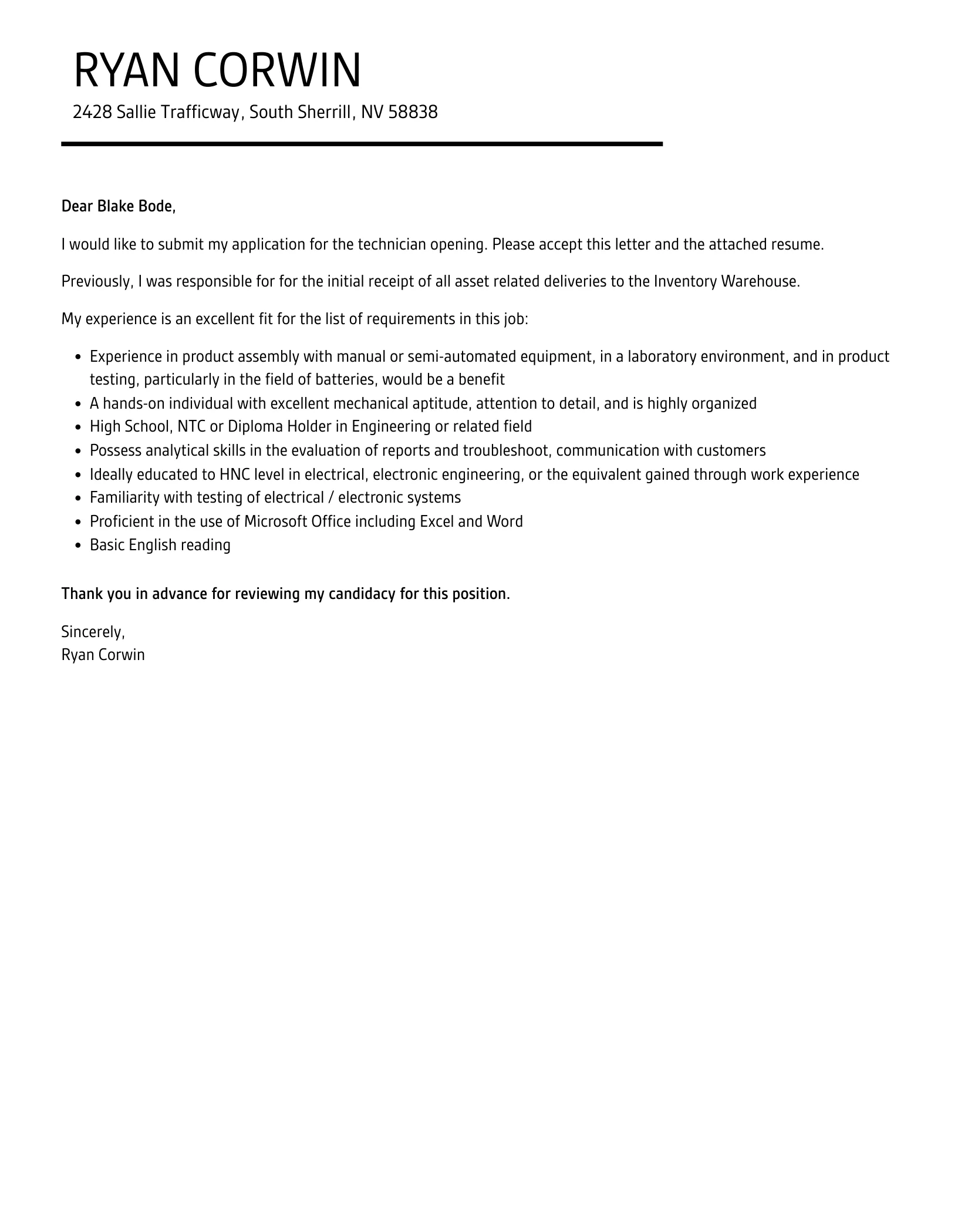
If possible, address the cover letter to a specific person, such as the hiring manager or the department head. Research the company’s website or LinkedIn to find the correct contact person. Include their name, title, and the company’s address. If you are unable to find a specific contact, you can use a general salutation, but addressing the letter to a named individual shows you have put in the effort to personalize your application. This extra step demonstrates initiative and a genuine interest in the role.
The Salutation
Start your cover letter with a professional salutation. ‘Dear Mr./Ms./Mx. [Last Name]’ is a standard and respectful greeting. If you don’t know the hiring manager’s name, use a general salutation such as ‘Dear Hiring Manager’ or ‘Dear [Company Name] Team’. Avoid overly casual greetings. The salutation sets the tone for the rest of your letter and is an essential part of establishing a professional and respectful tone from the beginning.
Crafting the Perfect Opening Paragraph
The opening paragraph is your chance to grab the reader’s attention and make a strong first impression. Start by stating the position you are applying for and where you found the job posting. Briefly mention your most relevant qualifications or a key skill that aligns with the job requirements. Show enthusiasm and express your interest in the company and the role. Keep it concise and focused, aiming to capture the reader’s interest from the start. A compelling opening will set a positive tone and encourage the hiring manager to continue reading your application. (Image filename technician-cover-letter-opening)
Highlighting Your Skills and Experience
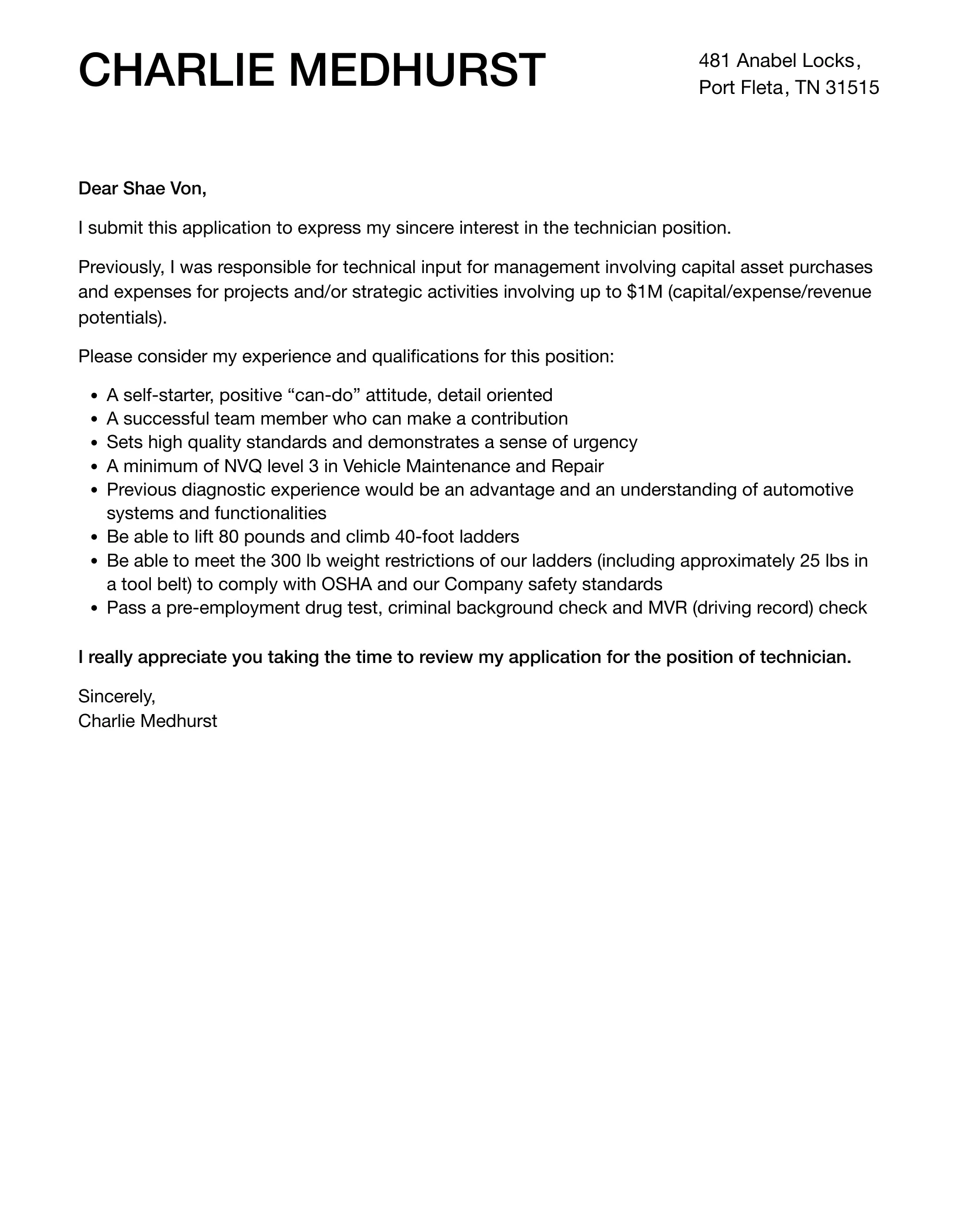
This is the core of your cover letter where you showcase your abilities and experience. Focus on the skills and experiences most relevant to the job description. Provide specific examples to demonstrate your qualifications. Avoid simply listing your skills; instead, explain how you have used them to achieve results. By providing concrete examples, you give the hiring manager a clearer picture of your abilities. Use action verbs to describe your accomplishments and quantify your achievements whenever possible. This section is an excellent opportunity to highlight your strengths and show how you can contribute to the company’s success. (Image filename technician-resume-skills)
Technical Skills to Showcase
Highlight your technical skills, such as troubleshooting, repair, maintenance, and diagnostics. Mention any specific equipment or software you are proficient with. Provide details about your experience with various tools and technologies relevant to the technician role. Customize this section to match the specific requirements listed in the job description. Make sure that you are demonstrating the qualifications the employer is seeking. This will set you apart as a strong candidate. (Image filename technician-technical-skills)
Software Proficiency
If the job requires software knowledge, mention the software programs you are familiar with. This might include diagnostic tools, operating systems, or specialized applications relevant to the industry. Be specific and mention your level of proficiency. Listing your software skills demonstrates your preparedness to perform the job tasks. Accurate and honest representation of your software knowledge is crucial as it shows how you will integrate into their processes.
Problem-Solving Abilities
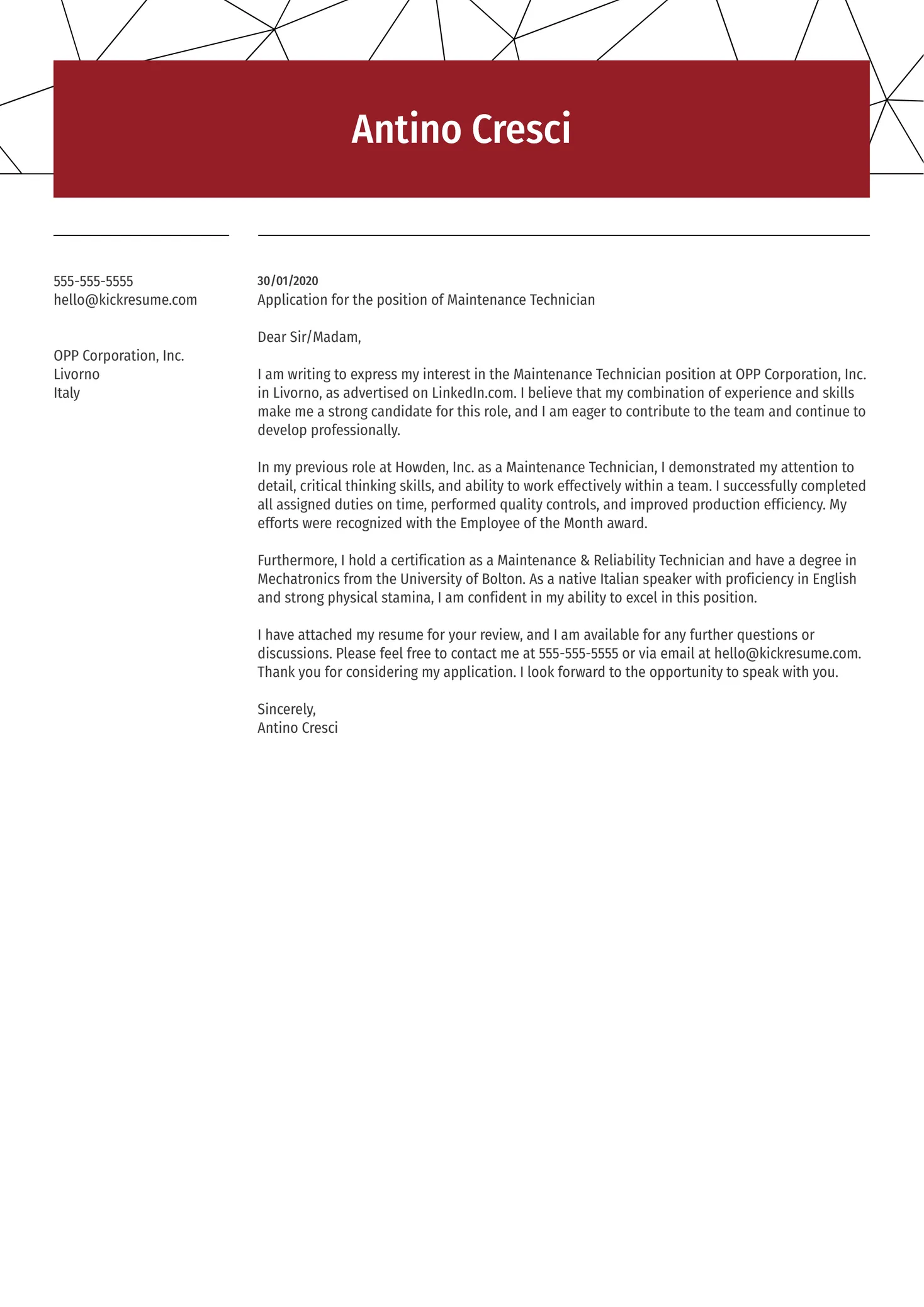
Technicians often encounter problems that require creative solutions. Provide examples of situations where you successfully identified and resolved technical issues. Emphasize your ability to analyze problems, diagnose issues, and implement effective solutions. Describe how you approached complex challenges, the steps you took, and the results you achieved. Demonstrating your problem-solving skills shows you can think critically and find the solutions the company requires. (Image filename technician-problem-solving)
Detailing Your Accomplishments
Instead of simply listing your job duties, focus on your accomplishments. Use the STAR method (Situation, Task, Action, Result) to describe specific situations and the actions you took to achieve positive outcomes. Highlight any projects where you exceeded expectations or contributed to significant improvements. Quantify your accomplishments whenever possible to demonstrate your value. Detailing your accomplishments provides concrete evidence of your abilities and potential. This provides a clear picture of how your performance benefited previous employers.
Quantify Your Achievements
Whenever possible, quantify your achievements with numbers and metrics. For example, state that you reduced downtime by a certain percentage, improved efficiency, or saved costs. Numbers add credibility to your claims and provide concrete evidence of your impact. When discussing your accomplishments, use numbers to make your achievements more compelling. This adds a level of detail that helps the employer understand your contributions and value.
Using Action Verbs

Start each bullet point or sentence describing your achievements with strong action verbs. Action verbs help to make your cover letter more dynamic and engaging. Examples include ‘managed,’ ‘implemented,’ ‘resolved,’ ‘improved,’ ‘maintained,’ and ‘diagnosed.’ Using active language adds energy and clarity to your descriptions, demonstrating your skills and experience effectively. Action verbs help to paint a vivid picture of your abilities.
Emphasizing Relevant Experience
Tailor your cover letter to the specific requirements of the job. Highlight the experience and skills most relevant to the position. Avoid including irrelevant information. Show you understand the employer’s needs and focus your response on demonstrating how you can meet them. Focus on your relevant experience to demonstrate your abilities to meet the requirements of the open position. Your goal is to show that your skills and experience are a direct match for the job’s requirements.
Tailoring to the Job Description
Customize your cover letter for each job application. Carefully review the job description and identify the key skills, experience, and qualifications the employer is seeking. Adjust your cover letter to address these specific requirements. By tailoring your letter, you show that you have carefully considered the role and are a good fit for the company. This attention to detail will show your dedication and initiative. It demonstrates that you understand the employer’s needs and are ready to contribute to the company.
Research the Company
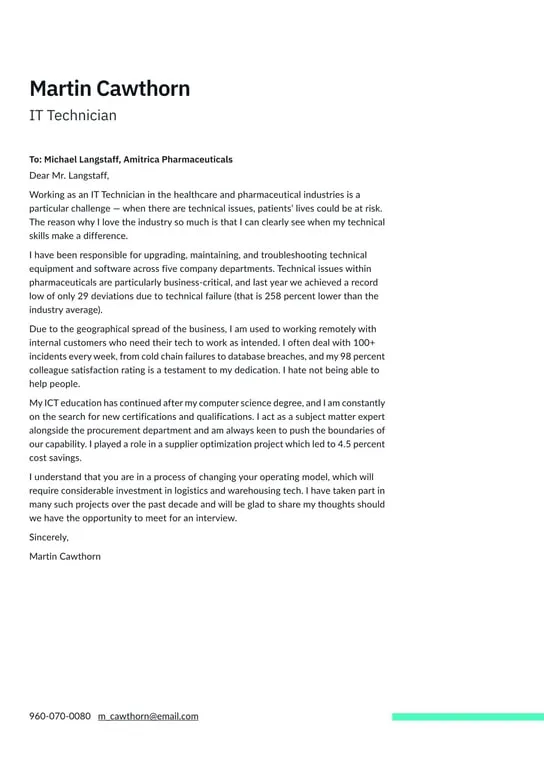
Before writing your cover letter, research the company and its values. Mention something specific about the company that interests you. This demonstrates your interest and shows that you have taken the time to learn about the organization. Researching the company can provide you with valuable insights that will help tailor your cover letter and demonstrate that you understand the employer’s mission and values. Show the company you care about their work.
Matching Skills to Requirements
Carefully compare the job description with your skills and experience. Identify the specific skills and qualifications the employer is seeking and highlight how you meet those requirements. Use the same keywords and phrases from the job description in your cover letter to show that you are a good match. Make sure that your skills align with what is expected of you. Ensure that you meet the criteria required by the employer.
The Closing Paragraph
The closing paragraph is your final opportunity to leave a positive impression. Reiterate your interest in the position and the company. Summarize why you are the best fit for the role and express your eagerness to discuss your qualifications further. Keep it concise and professional, and end with a call to action. A strong closing paragraph reiterates your qualifications and ensures a positive and memorable impression. (Image filename technician-closing-paragraph)
Expressing Enthusiasm
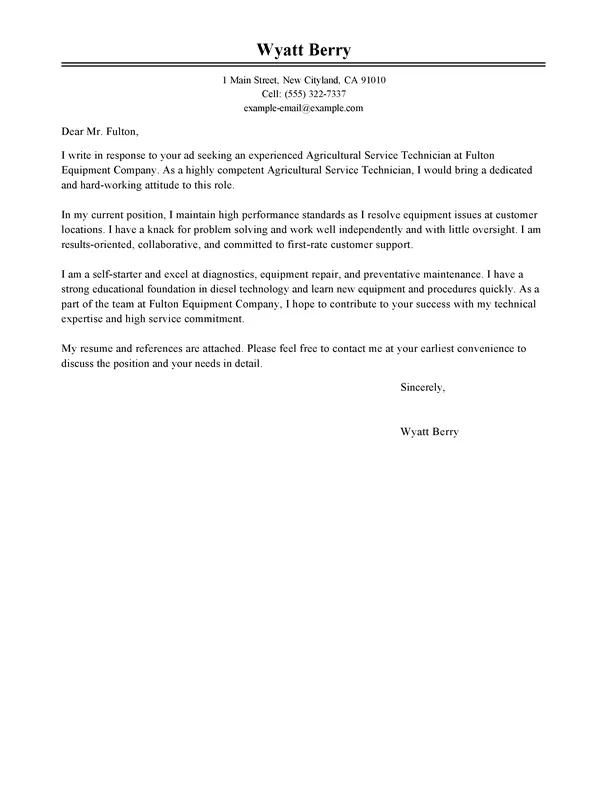
Express your enthusiasm for the position and the company. Show that you are genuinely interested in the opportunity and excited about the prospect of contributing to their team. Your enthusiasm should be genuine and reflect your understanding of the company’s values and mission. Showing excitement in your cover letter can go a long way to make you stand out from the competition.
Call to Action
End your cover letter with a clear call to action. State that you are available for an interview and look forward to hearing from them. Provide your contact information again. Make it easy for the hiring manager to take the next step. Ensure they know how to contact you to move forward. A strong call to action will encourage the hiring manager to reach out to you.
Proofreading and Editing
Before submitting your cover letter, carefully proofread and edit it for any errors. Check for typos, grammatical errors, and inconsistencies in formatting. Ask a friend or family member to review your letter as well. A polished and error-free cover letter shows attention to detail and professionalism. Proofreading ensures your application is well-presented and free from mistakes. This reinforces your professionalism and enhances the overall impression.
Common Mistakes to Avoid
Avoid common mistakes that can hurt your chances of getting an interview. Some of the most common mistakes include typos and grammatical errors, generic cover letters, and formatting issues. Being aware of and avoiding these mistakes will ensure your cover letter is professional and effective. Taking the time to avoid these pitfalls shows the employer that you are a detail-oriented and skilled professional.
Typos and Grammatical Errors
Typos and grammatical errors can make your cover letter appear unprofessional and careless. Always proofread your letter carefully and use spell-check and grammar-check tools. Errors create a negative impression, so it’s essential to be as accurate as possible. Errors can easily distract and undermine your message.
Generic Cover Letters
Avoid sending generic cover letters that could be sent to any company. Tailor your cover letter to each job application and demonstrate your understanding of the specific requirements of the role. Generic letters show a lack of effort and interest in the opportunity. By customizing your cover letter, you demonstrate your attention to detail and genuine interest in the position.
Formatting Issues
Ensure your cover letter is well-formatted and easy to read. Use a professional font, appropriate margins, and clear paragraph breaks. Poor formatting can make your letter appear cluttered and unprofessional. Proper formatting makes your cover letter visually appealing and easy to read, making a positive impression.
Cover Letter Examples for Different Technician Roles
Cover letter examples for IT, medical, and automotive technicians vary depending on the specific skills and qualifications required for each role. Reviewing these examples can help you tailor your own cover letter to the specific requirements of the job. The best way to get a cover letter that works for you is to study relevant examples. This will help you understand the formatting and content. This is especially helpful when tailoring the letter to your needs. These examples can guide you in highlighting your unique qualifications effectively.
IT Technician Cover Letter Example
An IT technician cover letter should highlight your experience with hardware and software troubleshooting, network administration, and data security. Mention specific operating systems, hardware, and software that you are proficient with. Describe your experience with help desk support, system maintenance, and user training. Include a description of your IT certifications. Show that you understand the job’s requirements. (Image filename it-technician-cover-letter)
Medical Technician Cover Letter Example
A medical technician cover letter should emphasize your experience with medical equipment, patient care, and lab procedures. Mention specific medical instruments and procedures you are familiar with. Highlight your experience with diagnostic testing, specimen collection, and quality control. Include examples of patient care and the ability to work in a fast-paced environment. Showing the employer you are able to fulfill their needs in a medical setting is the main goal.
Automotive Technician Cover Letter Example
An automotive technician cover letter should focus on your skills with vehicle repair, diagnostics, and maintenance. Highlight your experience with specific vehicle makes and models, diagnostic tools, and repair procedures. Describe your experience with engine repair, electrical systems, and brake systems. Include your ASE certifications and any specialized training. Automotive Technician cover letters should show how you fulfill the job requirements. (Image filename automotive-technician-cover-letter)
